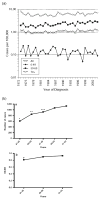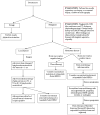Male breast cancer: an update in diagnosis, treatment and molecular profiling
- PMID: 20138719
- PMCID: PMC3253821
- DOI: 10.1016/j.maturitas.2010.01.012
Male breast cancer: an update in diagnosis, treatment and molecular profiling
Erratum in
- Maturitas. 2010 Jun;66(2):220
Abstract
Significant advances have been made in the diagnosis and treatment of female breast cancer, resulting in a decline in incidence and a global improvement in clinical outcome. The statistics for male breast cancer (MBC) stand in sharp contrast-over the past several decades, there has been a steady rise in the incidence of this disease, and clinical outcome has improved at a much slower pace. In the current review, the clinicopathologic features of MBC are described in detail. An emphasis is placed on molecular profiling of MBC, which may identify candidate biomarkers and putative targets for pharmacologic intervention. The current role of cytotoxic chemotherapy and endocrine therapy (including tamoxifen, aromatase inhibitors and GnRH analogues) is defined in the context of currently available studies. Furthermore, the potential role of targeted agents, including HER2-directed therapies, PARP inhibitors, and angiogenesis inhibitors, is delineated.
Copyright 2010 Elsevier Ireland Ltd. All rights reserved.
Figures


Similar articles
-
Clinical aspect of male breast cancer: a burgeoning and unaddressed issue.Mol Biol Rep. 2025 May 13;52(1):452. doi: 10.1007/s11033-025-10558-4. Mol Biol Rep. 2025. PMID: 40358767 Review.
-
Genotypic and phenotypic analysis of familial male breast cancer shows under representation of the HER2 and basal subtypes in BRCA-associated carcinomas.BMC Cancer. 2012 Nov 9;12:510. doi: 10.1186/1471-2407-12-510. BMC Cancer. 2012. PMID: 23146383 Free PMC article.
-
Long-term survival and BRCA status in male breast cancer: a retrospective single-center analysis.BMC Cancer. 2016 Jul 4;16:375. doi: 10.1186/s12885-016-2414-y. BMC Cancer. 2016. PMID: 27377827 Free PMC article.
-
Male Breast Cancer (MBC) - A Review.Pol Przegl Chir. 2023 Dec 30;95(6):24-30. Pol Przegl Chir. 2023. PMID: 38058163 Review.
-
Comprehensive review of male breast cancer: Understanding a rare condition.Oncol Res. 2025 May 29;33(6):1289-1300. doi: 10.32604/or.2025.058790. eCollection 2025. Oncol Res. 2025. PMID: 40486874 Free PMC article. Review.
Cited by
-
Male breast cancer: a report of 25 cases.Pan Afr Med J. 2020 Dec 15;37:343. doi: 10.11604/pamj.2020.37.343.23004. eCollection 2020. Pan Afr Med J. 2020. PMID: 33738031 Free PMC article.
-
Cardiovascular toxicity associated with adjuvant trastuzumab therapy: prevalence, patient characteristics, and risk factors.Ther Adv Drug Saf. 2014 Aug;5(4):154-66. doi: 10.1177/2042098614529603. Ther Adv Drug Saf. 2014. PMID: 25083270 Free PMC article. Review.
-
Aromatase inhibitors with or without gonadotropin-releasing hormone analogue in metastatic male breast cancer: a case series.Br J Cancer. 2013 Jun 11;108(11):2259-63. doi: 10.1038/bjc.2013.255. Epub 2013 May 30. Br J Cancer. 2013. PMID: 23722469 Free PMC article.
-
Identification of a new BRCA2 large genomic deletion associated with high risk male breast cancer.Hered Cancer Clin Pract. 2015 Jan 16;13(1):2. doi: 10.1186/s13053-014-0022-x. eCollection 2015. Hered Cancer Clin Pract. 2015. PMID: 25632310 Free PMC article.
-
Breast cancer risk factors.Prz Menopauzalny. 2015 Sep;14(3):196-202. doi: 10.5114/pm.2015.54346. Epub 2015 Sep 30. Prz Menopauzalny. 2015. PMID: 26528110 Free PMC article. Review.
References
-
- Ravdin PM, Cronin KA, Howlader N, et al. The Decrease in Breast-Cancer Incidence in 2003 in the United States. N Engl J Med. 2007;356:1670–1674. - PubMed
-
- Writing Group for the Women's Health Initiative Investigators. Risks and Benefits of Estrogen Plus Progestin in Healthy Postmenopausal Women: Principal Results From the Women's Health Initiative Randomized Controlled Trial. JAMA. 2002;288:321–333. - PubMed
-
- Stang A, Thomssen C. Decline in breast cancer incidence in the United States: what about male breast cancer? Breast Cancer Research and Treatment. 2008;112:595–596. - PubMed
-
- Speirs V, Shaaban A. The rising incidence of male breast cancer. Breast Cancer Research and Treatment. 2009;115:429–430. - PubMed
-
- Giordano SH, Buzdar AU, Hortobagyi GN. Breast Cancer in Men. Annals of Internal Medicine. 2002;137:678–687. - PubMed
Publication types
MeSH terms
Substances
Grants and funding
LinkOut - more resources
Full Text Sources
Medical
Research Materials
Miscellaneous

